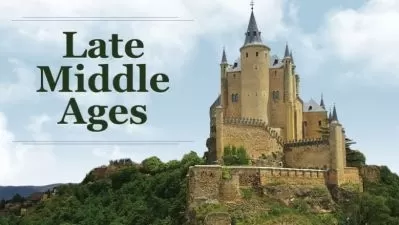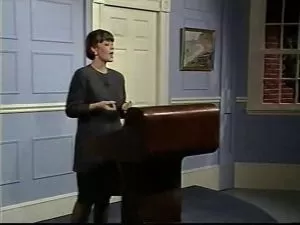Late Antiquity: Crisis and Transformation
Thomas F. X. Noble
18:28:55
Description
Edward Gibbon's stirring Decline and Fall of the Roman Empire painted an unforgettable portrait of the Roman Empire in a long, debilitating slide to oblivion, culminating in an agonizing death at the hands of barbarian savages. But two centuries after Gibbon, historians have reevaluated this picture to create a radically different understanding of the period, which they now call "late antiquity."
This new view posits several fundamental changes:
- "Barbarians" were not all one people; they weren't particularly barbaric; and they entered the empire mostly by invitation or migration—not by invasion.
- The sack of Rome by Visigoths in 410 was effectively a looting spree. Churches were spared and there was no slaughter of the population.
- The "fall" of the western Roman Empire in 476 was hardly noticed by people at the time. It was only long after the fact that it was seen as a cataclysmic event.
- Contrary to Gibbon's view of Christianity as a cause of Rome's decline, much of the empire's legacy lived on through the institutions of the church.
Far from being a period of decline and fall, late antiquity marked one of history's great turning points. The fundamental reordering of the Roman Empire that took place spawned three great civilizations: Medieval Europe, the Byzantine Empire, and the Islamic Caliphate. This startling transformation survives to the present day in many of the political, cultural, and religious traditions spanning the region from the British Isles to the Middle East—traditions that have spread their influence around the planet.
Late Antiquity: Crisis and Transformation takes you through five momentous centuries that link the Classical world with the modern, in 36 half-hour lectures by distinguished medieval historian Dr. Thomas F. X. Noble, Professor of History and Chair of the Department of History at the University of Notre Dame.
Continuity and Innovation
A brisk and entertaining lecturer and winner of prestigious teaching awards from the University of Virginia and Notre Dame, Professor Noble shows in fascinating detail how one storied era, the Roman Empire, gradually faded into something remarkably new but also recognizably the same.
Covering the period from A.D. 235 to 750, Late Antiquity opens with Rome near its pinnacle of power and geographical extent, stretching from Mesopotamia in the east to Spain in the west; from the Sahara Desert at the empire's southern limit to the Scottish highlands, the Rhine, and the Danube at its northern frontier. Yet severe cracks were beginning to appear. One portent of trouble: Between 235 and 284, a succession of 70 legitimate emperors and usurpers waged a bloody struggle for imperial control.
Five hundred years later, the map over which these men fought was almost unrecognizable. The Byzantine Empire, centered at Constantinople, was the only administrative division of the old Roman Empire still extant. From the east through North Africa to Spain, the new civilization of Islam ruled. And most of what had once been the western Roman Empire had broken into a succession of barbarian Christian kingdoms.
But where earlier generations of historians saw the end of Roman civilization, the new scholarly consensus is that Rome was reinventing itself, seeding its customs and culture into the sibling civilizations of western Christianity, Byzantium, and Islam.
In this course, you explore these key features of late antiquity:
- How this tripartite division occurred
- The memorable rulers who led the way, such as the Roman emperors Diocletian, Constantine, and Justinian; the barbarian kings Alaric and Clovis; and the Islamic caliphs Mu'awiya and Abd al-Malik
- The advances in systematizing legal codes, which made late antiquity one of the greatest periods of jurisprudence in history, contrary to its reputation as a time of decay and disorder
- The ebb and flow of different barbarian peoples, who were often ethnically diverse confederations of disparate tribes
- The religious leaders who forged Christianity and Islam, including Anthony, John Chrysostom, Ambrose, Jerome, Augustine, and Muhammad
- The architecture, visual arts, and literature of the period, which reflected both continuity with existing classical models and daring innovation
You also learn what it was like to live in the late antique world, how people earned their livings, how the rich and poor differed, the role of women in society, and the great cities of the era and what distinguished them.
New Institutions, States, Religions, and Arts
The long course of Roman history had its share of surprises, with stretches of stability punctuated by wars and the rise of successive rulers. But nothing in Rome's previous experience compared with the ferment of late antiquity, which saw the unpredictable growth of new institutions, states, religions, and arts. A betting person at the time, says Professor Noble, would have been very reluctant to risk a wager on any of the following developments, which in fact came to pass:
- that the crisis of the 3rd century would be resolved by a seemingly ordinary general named Diocletian, who became emperor and gave the moribund empire a new lease on life for another two centuries;
- that the followers of Jesus would not only establish the Roman state religion but also amass powers exceeding those of the emperor;
- that the Old Testament prohibition against graven images would be ignored by most Christian leaders, sparking the spectacular growth of creative visual arts in the church; and
- that, most shocking of all, a new religion called Islam would arise among the desert tribes of Arabia, with militant adherents who would take over permanently a large part of the Roman Empire.
A Period of Transition
At the start of late antiquity, Christianity was a persecuted sect. A century later, Constantine legalized the faith and embraced it himself, attributing to Christ the victory that made him sole emperor. But when he built his triumphal arch in Rome, he identified his benefactor only as "the highest god," an ambiguous phrase designed not to offend pagans. This perfectly illustrates how late antiquity was a transitional period, with a new order and new sensibilities taking hold only gradually.
Professor Noble shows this transformation occurring in many areas, including philosophy, history, and poetry. For example, Christianity took ancient philosophy in an entirely new direction, with thinkers such as the church father Augustine challenging and adapting classical ideas to create a rigorous new theology. In fact, Augustine qualifies as the most prolific author in the Latin language, surpassing even Cicero in his ceaseless devotion to setting his wide-ranging thoughts to paper.
The traditional classification of literary periods divides pagan from Christian, even though the early Christian writers adopted classical models in their use of rhetoric, literary genres, and poetic meters. You learn why it makes much more sense to see the writings of the church fathers and other late antiquity authors as the last great age of ancient literature.
Five Eventful Centuries Made Clear
Anyone who has ever consulted a historical atlas cannot help but be struck by the mercurial, often confusing maps that represent late antiquity. The DVD version of this course features hundreds of specially designed maps (some of which are also included in the course booklet) that marvelously clear up the story of shifting peoples and borders over the course of five eventful centuries. Created under Professor Noble's direction, these visual aids are unique for any comparable presentation of the subject.
Another way Professor Noble clears up confusion is by casting the ethnic identities of the barbarians in an intriguing new light. "No premodern people we know about ever called themselves German," he says. Similarly, the Visigoths, Vandals, Franks, and other groups who are traditionally pictured as tribal hoards knocking down the gates of the empire are really complex amalgams of different peoples, who forged a unified identity under the process of ethnogenesis and then settled the Roman Empire under a wide range of circumstances—some violent, most not.
After taking this course you will never think of the barbarians and the "fall" of Rome in quite the same way again. Your imagination will be alive with the incidents, innovations, and peoples of an exciting era that gave birth to us all: late antiquity.
More details
User Reviews
Rating
Thomas F. X. Noble
Instructor's CoursesDr. Thomas F. X. Noble is Professor of History at the University of Notre Dame. He earned his B.A. in History from Ohio University and his M.A. and Ph.D. in Medieval History from Michigan State University. Professor Noble has held fellowships from the National Endowment for the Humanities and research grants from the American Philosophical Society. In 2008 he received the Edmund P. Joyce, C.S.C., Award for Excellence in Teaching from Notre Dame. In 1999 he was awarded the Alumni Distinguished Professor Award and a David Harrison III Award for outstanding undergraduate advising, both from the University of Virginia. Professor Noble is the author, coauthor, or editor of 10 books and has published more than 40 articles, chapters, and essays. His coauthored textbook, Western Civilization: The Continuing Experiment, is in its 5th edition. His research has concentrated on late antiquity and the early Middle Ages, focusing on the history of the city of Rome, the history of the papacy, and the age of Charlemagne.

The Great Courses
View courses The Great Courses- language english
- Training sessions 37
- duration 18:28:55
- English subtitles has
- Release Date 2023/06/06





















